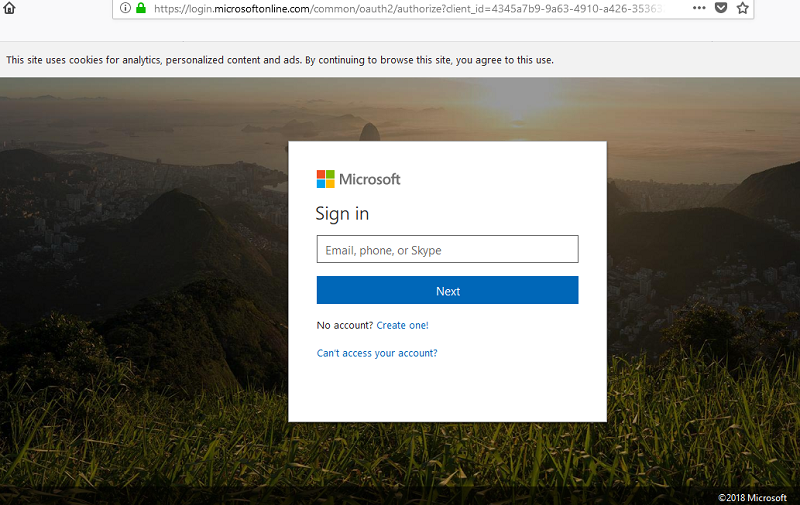

- LOGIN MICROSOFT OUTLOOK 365 HOW TO
- LOGIN MICROSOFT OUTLOOK 365 INSTALL
- LOGIN MICROSOFT OUTLOOK 365 DOWNLOAD
- LOGIN MICROSOFT OUTLOOK 365 WINDOWS
LOGIN MICROSOFT OUTLOOK 365 HOW TO
How to perform a silent installation for a new agent installation
LOGIN MICROSOFT OUTLOOK 365 DOWNLOAD
Go to the Microsoft Download Center to manually download the agent installation package for new agent installations. Msiexec.exe /p StorageSyncAgent_WS2016_KB5013877.msp REINSTALLMODE=OMUS REINSTALL=StorageSyncAgent,StorageSyncAgentAzureFileSync,StorageSyncAgentGuardFilter,StorageSyncAgentUpdater /qb /l*v KB5013877.log Microsoft Download Center
LOGIN MICROSOFT OUTLOOK 365 INSTALL
Msiexec.exe /p packagename.msp REINSTALLMODE=OMUS REINSTALL=StorageSyncAgent,StorageSyncAgentAzureFileSync,StorageSyncAgentGuardFilter ,StorageSyncAgentUpdater /qb /l*v KB5013877.logįor example, to install the Azure File Sync agent update for Server 2016, run the following command: To manually install the update package, extract the cab file and run the following command from an elevated command prompt: Go to the following website to manually download this update from the Microsoft Update Catalog:Īzure File Sync Agent v16 release: January 2023 (KB5013877) Verify the Azure File Sync agent update is selected, and then click Install.
LOGIN MICROSOFT OUTLOOK 365 WINDOWS
In the Windows Update window, click Check for updates. In Control Panel, double-click Windows Update. Verify the Azure File Sync agent update is listed and then click Install now.Ĭlick Start, and then click Control Panel. In the Windows Update window, click Check online for updates from Microsoft Update. Windows Server 2022, Server 2019 and Server2016 To obtain and install from Microsoft Update, follow these steps on a server that has Azure File Sync agent installed: To update existing agent installations, run AfsUpdater.exe (located in the agent installation directory) or download and install the update from Microsoft Update or Microsoft Update Catalog. The agent installation package on Microsoft Update and Microsoft Update Catalog is intended for agent upgrades only.

If the Azure File Sync agent is not currently installed on a server, use the agent installation package on the Microsoft Download Center. The Azure File Sync agent is available from Microsoft Update, Microsoft Update Catalog, and Microsoft Download Center. How to obtain and install the Azure File Sync Agent The agent version for this release is 16.0.0.0. This release is available for Windows Server 2012 R2, Windows Server 2016, Windows Server 2019, and Windows Server 2022 installations. Miscellaneous reliability and telemetry improvements for cloud tiering and sync More information about the Azure File Sync Agent v16 release To perform a deeper check, use the -DeepScan parameter.īug fix for the PowerShell script FileSyncErrorsReport.ps1 Note: By default, the server change enumeration scan will only check the modified timestamp. Invoke-StorageSyncServerChangeDetection -ServerEndpointPath Import-Module "C:\Program Files\Azure\StorageSyncAgent\" To immediately run server change enumeration on a server endpoint path, run the following PowerShell commands: If you don't want to wait until the next server change enumeration job runs, you can now use the Invoke-StorageSyncServerChangeDetection PowerShell cmdlet to immediately run server change enumeration on a server endpoint path. Azure File Sync has a server change enumeration job that runs every 24 hours on the server endpoint path to detect changes that were missed by the USN journal. If files changed are missed due to journal wrap or other issues, the files will not sync to the Azure file share until the changes are detected. Immediately run server change enumeration to detect files changes that were missed on the serverĪzure File Sync uses the Windows USN journal feature on Windows Server to immediately detect files that were changed and upload them to the Azure file share. Azure File Sync will be zone-redundant in these regions in the near future. Note: Azure File Sync is zone-redundant in all regions that support zones except US Gov Virginia. To learn more about different redundancy options for your storage accounts, see: Azure Storage redundancy

To fully leverage this improvement, configure your storage accounts to use zone-redundant storage (ZRS) or Geo-zone redundant storage (GZRS) replication. Improved Azure File Sync service availabilityĪzure File Sync is now a zone-redundant service which means an outage in a zone has limited impact while improving the service resiliency to minimize customer impact. Additionally, this article contains installation instructions for this release. This article describes the improvements and issues that are fixed in the Azure File Sync Agent v16 release that is dated January 2023.


 0 kommentar(er)
0 kommentar(er)
